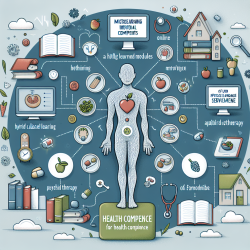Introduction
Urban environments have long been a focus of research when it comes to public health outcomes. The study titled "Urban Natural Environments, Obesity, and Health-Related Quality of Life among Hispanic Children Living in Inner-City Neighborhoods" offers valuable insights into how urban green spaces can influence health-related quality of life (HRQOL) among children, particularly those in Hispanic communities. This research is crucial for practitioners, especially those involved in speech-language pathology and online therapy services like TinyEYE, to understand the broader context of a child's health and well-being.
Key Findings from the Research
The study assessed 92 fourth and fifth-grade students from Houston, Texas, focusing on the relationship between urban natural environments and HRQOL. Using the Pediatric Quality of Life Inventory (PedsQL), the study found a negative correlation between children's body mass index (BMI) and HRQOL. Interestingly, larger and more tree-dense areas were positively associated with improved HRQOL, while children living in areas with tree patches further apart also reported higher HRQOL.
This suggests that not only the presence of green spaces but also their spatial arrangement can significantly impact children's health outcomes. The findings underscore the importance of considering environmental factors when addressing health and educational interventions for children.
Implications for Practitioners
For practitioners in speech-language pathology and related fields, these findings highlight the importance of a holistic approach to child health. Here are some actionable insights:
- Incorporate Environmental Context: When assessing a child's progress or challenges, consider their living environment. Are they in an area with ample green space?
- Advocate for Green Spaces: Encourage schools and communities to invest in creating and maintaining green spaces. These areas can serve as therapeutic environments that enhance HRQOL.
- Encourage Outdoor Activities: Promote activities that encourage children to spend time in nature, which can improve both physical and mental health outcomes.
Encouraging Further Research
While this study provides valuable insights, it also opens up avenues for further research. Practitioners are encouraged to explore how specific types of green spaces might influence different aspects of HRQOL, such as emotional and social functioning. Additionally, research can be expanded to include diverse populations and settings to understand better the universal applicability of these findings.
Conclusion
The study offers a compelling case for the integration of urban planning and public health strategies to improve children's health outcomes. As practitioners, understanding the role of the environment in child development can lead to more effective interventions and advocacy for healthier living conditions.
To read the original research paper, please follow this link: Urban Natural Environments, Obesity, and Health-Related Quality of Life among Hispanic Children Living in Inner-City Neighborhoods.










